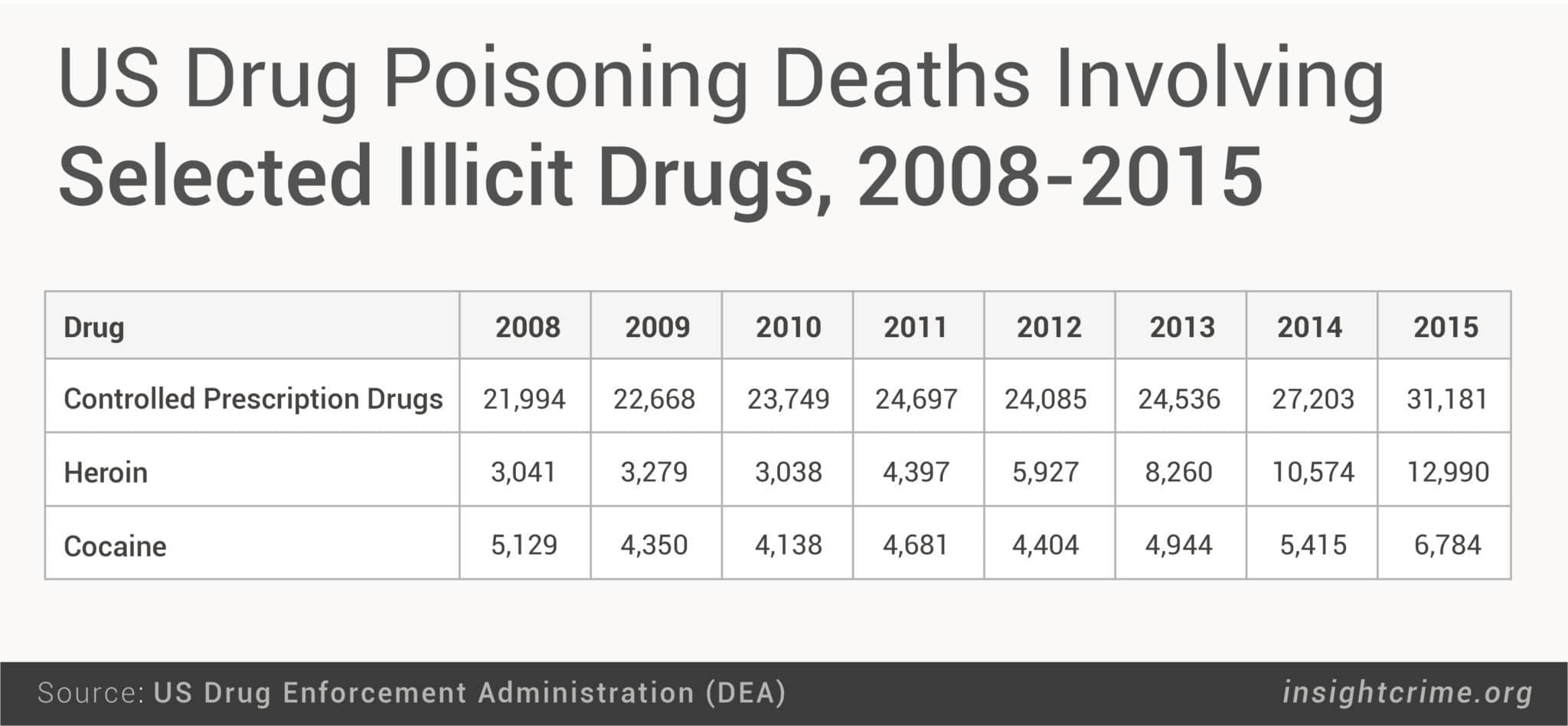The homegrown problem of prescription painkiller abuse continues to be the biggest, deadliest drug threat to the United States, according to the DEA’s latest National Drug Threat Assessment report. The Trump administration must focus on prevention at home as well as anti-narcotic measures abroad, if it is to tackle the problem.
Never have so many people died in the United States as a result of drug overdoses, according to the 2017 National Drug Threat Assessment, the annual report by the US Drug Enforcement Administration (DEA).
Released on October 23, the study says there were 52,000 overdose deaths in 2015, the most recent year for which data is provided. This figure is once again higher than any other injury deaths including suicides, homicides or deaths resulting from car crashes.
Opioid-based drugs, including legal prescription pills as well as heroin and legal and illicit fentanyl — an extremely potent synthetic opiate that is produced both legally and clandestinely — were responsible for 63 percent of the 52,000 drug-related deaths. In other words, 91 people died every day on average in the United States during 2015 due to an opioid overdose.
The abuse of controlled prescription drugs (CPD), which include but are not limited to legal opioid medicine, was responsible for 31,000 deaths in 2015. That is more than double the roughly 13,000 lethal overdoses of heroin that same year. Death from cocaine use comes next, with approximately 6,800 victims in 2015.

The report does note a declining availability and a slight decrease in the abuse of CPDs. But it also suggests that heroin use may have increased as a consequence, as opioid users switch from prescription pills to cheaper, often more easily available, heroin, mostly from Mexico. Still, the DEA notes that “survey, treatment, and demand data indicate epidemic levels of CPD abuse.”
With regard to heroin, the DEA’s data indicates that availability has increased, and the number of overdose deaths has exploded by nearly 330 percent since 2010. In addition, the report touches on the growing threat of synthetic opioids such as fentanyl that is increasingly mixed with heroin and is far more deadly. Mexico remains the top supplier of the heroin market in the United States: 93 percent of the heroin tested was judged to be from Mexican origin, a record since the launch of the DEA Heroin Signature Program (HSP) program in 1977.
The DEA’s report claims that fentanyl may be “supplanting the heroin market” in certain areas, although the report does not offer any concrete data to support that assertion. Rather, the claim appears to rest mainly on fentanyl’s massive profitability for relatively small volumes of the drug. In comparison to heroin, cocaine and marijuana, fentanyl is so potent that traffickers need to produce and move very little amounts to make big profits, which arguably makes it a must-have for criminal organizations.
The DEA document does report a positive decline in users and individuals trying heroin for the first time. But consumption of the drug continues to grow, and the outlook does not foresee any decrease in heroin use and abuse in the near future.
SEE ALSO: Coverage of Heroin
With regard to transnational organized crime, overall trends appear similar to previous years. Mexican trafficking groups remain the most influential in the United States, with the Sinaloa Cartel and the Jalisco Cartel – New Generation (Cartel de Jalisco Nueva Generación – CJNG) commanding the greatest reach. Colombia’s underworld remains the major cocaine supplier for Mexican cartels.
InSight Crime Analysis
US officials have increasingly voiced their concerns over record drug trends, and many have pointed the finger at Mexico’s growing poppy cultivation for the opioid crisis in the United States. Others have described Colombia’s boom in cocaine production as responsible for a claimed but uncertain increase in cocaine consumption in the United States. The DEA’s latest report indicates that these are legitimate concerns, but suggests that their priorities could be confused: the country’s deadliest drug issue is homegrown.
There is now little doubt that the widespread prescription of addictive drugs (particularly opioid painkillers), spurred by pharmaceutical companies’ search for profits and a lack of government control, are the main culprits for creating the opioid epidemic the United States faces today. Last July, the Commission on Combating Drug Addiction and the Opioid Crisis called on President Donald Trump to declare the issue a national emergency.
The unregulated and excessive prescription of powerful painkillers also stands directly accused of having precipitated the boom in heroin use, which has been a boon for criminal groups. Heroin suppliers are now lacing their products with deadly fentanyl to give a better high and increase profits.
“I don’t have any studies to back this up, because this is happening in real time, but I know for a fact that nearly all the folks who are switching to heroin were pill addicts,” Sam Quiñones, the author of “Dreamland: The True Tale of America’s Opiate Epidemic,” told InSight Crime over the phone. “I have never met a heroin addict, in all the research I’ve done in the last 15 years, who did not first start with those [legal opioid] pills, in one form or another, either recreationally, or because he was prescribed those pills.”
This link is also raised by the DEA’s report, drawing a correlation between decreasing CPD and increasing heroin consumptions.
SEE ALSO: Coverage of Drug Policy
“The pills, the heroin, the fentanyl, it’s all part of a logical conclusion that started with the legitimate market of doctors and pharmaceutical companies igniting a massive demand with a huge supply,” Quiñones said. “That demand started igniting the interest of Mexican traffickers, who did what they do best: making as much money as they can no matter how moral or immoral what they’re selling is.”
As the Trump administration promises to focus its anti-narcotic strategy on repressive law enforcement measures, both at home and abroad, the latest report on drug trends in the United States carries strong policy implications. It points to the dire need for treatment and prevention, as well as more regulation of the companies and actors involved in producing and distributing CDPs.
“When you’re in a hole, the first thing you’ve got to stop doing is digging and making the hole bigger. These pills do have very solid and legitimate medical uses, but we really need to get doctors thinking about why they’re prescribing and to whom,” argued Quiñones.
Despite the growing awareness over the origins of the United States’ current drug epidemic, curtailing the widespread prescription of opioids promises to be an uphill battle. A recent Washington Post – CBS News investigation revealed how a multi-million dollar lobbying effort by pharmaceutical companies succeeded in pushing through a 2016 bill under President Barack Obama that stripped the DEA and the US Justice Department of a critical legal tool to slow the flow of the CPDs to drug stores and other major distributors when abuse was evident. The bill was championed by Tom Marino, a Republican Representative selected by Trump to become the next US drug czar. After the report surfaced, Marino withdrew his name.
“This is a problem that we got into because we wanted to have an easy answer to this enormously complicated problem of how to deal with human pain. Every person is so different, each kind of pain is so different…What was the easy answer? Pills for everybody,” Quiñones said. “We need to get away from that impulse of trying to find easy answers…It will require commitment from the highest levels…It needs a serious, long term push from the top [and] the distracted nature of this administration is scary for that reason.”

